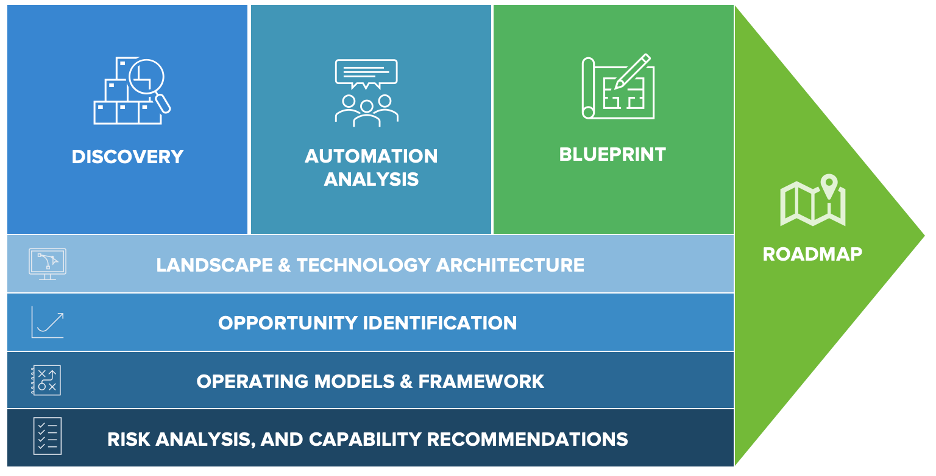Leonardo’s Enterprise Automation Strategy & Roadmap
Helping organisations identify and navigate their Automation & AI objectives to create a strategic blueprint for an intelligent automation future.
Discovery (Current State Assessment & Strategic Objectives)
Automation Analysis and Shortlist
Blueprint
and Roadmap
What is Leonardo’s Automation Strategy & Roadmap?
1. Landscape analysis of automation current state
Includes practices, technologies, operating models, strategic and digital objectives, process and governance practices and automation aspirations
2. Automation & AI analysis & opportunity identification
Includes analysis, framework and operating models, platform identification and shortlisting, governance and risk analysis, and capability recommendations
3. Blueprint and Roadmap for automation future state
Includes prioritised, time-based phases to establish, embed and scale automation practices across process, platform, architecture, governance and capability perspectives
Managing your automation initiatives is getting harder and more costly for enterprises
The increase of personal and application automation technologies plus disruption of AI is making it harder to align automation initiatives with strategic objectives and understand future use cases across business units.
There is no centralised model to bring simplicity and efficiency to automation efforts.
Automation is fragmented and in isolation
Data security and privacy is compromised
No framework for the right automation tool
Struggling to scale
Automation is seen as a threat, not an opportunity
Ungoverned Automation and AI = Increased Enterprise Chaos
Adhoc and ungoverned approach to , coupled with the disruption caused by AI and chatbots, is leading to increased chaos and inefficiencies within organisations.
Leonardo's Enterprise Automation Strategy & Roadmap

How an Automation strategy can help your enterprise
Prioritised automation initiatives
Allows the enterprise to plan and prioritise their automation initiatives, ensuring that resources are allocated effectively to the most impactful projects. Focus on the right automation, at the right time, for the right reasons… not just the squeakiest wheel.
Improved Coordination and Alignment
Coordinate and align automation initiatives across different departments and business units, leading to a more integrated and streamlined approach. Automation is a proactive tool to deliver benefits to customers, staff and stakeholders alike, and should be seen as a value-add, not a spot-fix.
A framework for investment
Better understand costs, measure the success of automation efforts, and inform future decision-making – automation enables teams and organisations to make continuous improvements and achieve their desired outcomes.
Focus on enterprise objectives not technical platform
Organisations can better understand how to use the right technologies to drive end-to-end outcomes by focusing primarily on the process and the outcome delivered, not the technical platform used.
Better Stakeholder Engagement
Engage stakeholders, ensuring that all parties are aware of the organisation’s automation goals and priorities, and are aligned behind a shared vision. Automating manual processes frees up time for higher-value tasks and boosts employee experience, customer satisfaction, and staff retention.
Measuring Success
Having a clear Enterprise Automation Strategy, Roadmap and Blueprint in place can help organizations measure the success of their automation efforts, allowing them to make continuous improvements and achieve their desired outcomes.
Frequently asked questions
1. How long does an Automation Strategy take to form?
Depending on the size and complexity of the organisation and the scope of work, the Strategy activity will likely take between 3 and 12 weeks to complete. This includes the Discovery > Analysis > Blueprint/Roadmap phases.
2. What will it cost?
We work with our clients to tailor the project team to the size and complexity of the organisation and scope of work. For shorter/simpler engagements, the Strategy will likely cost around $35k AUD, but we recommend having an initial conversation with one of our team to understand more about your situation and get a more accurate idea of cost and duration.
3. What do I need to provide to enable a Strategy to be compiled?
We will usually conduct a number of interviews and stakeholder workshops to understand current state practices, as well as review a range of artefacts, systems and architectural practices as part of the Discovery Phase. We will discuss these in detail prior to commencing work.
4. What do I get out of it?
The engagement will deliver a bespoke Automation Strategy and Prioritised Roadmap including time-based targets and capability uplifts. Each horizon includes indicative costs/benefits with people/process/system insights and relevant benefits/assumptions and is supported by the underlying analysis and prioritisation logic. This Roadmap/Blueprint serves as an input artefact to implementing (or improving an existing) Automation practice and building a mature capability within your organisation.
Resources
We can help! Contact us for a free discovery session
Do you have an upcoming project or outcome you'd like to discuss?
Do you need help with your business design?
Are you trying to figure out how automation impacts your business?
Are you limited by your current system integrations?
Are you trying to manage your containerised platform?
Get in touch with Leonardo. One of our amazing team will reach out to you to talk through your challenges and needs.

E-mail address
info@leonardo.com.au

Talk to us
+61 1800 717 554

Get in touch

